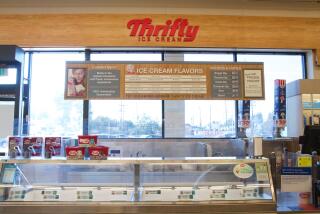Ice Cream Maker Stirs Up Plan to Fatten Sales
- Share via
Chocolatier magazine may have named McConnell’s Fine Ice Creams one of the “best homemade ice creams in the nation,” but the tiny Santa Barbara company still struggles to get its super-premium product on local store shelves and to keep its factory busy.
When Jimmy Young took over the half-century-old business from his stepfather two years ago, he was determined to get McConnell’s high-butterfat flavors onto the spoons of a much wider audience and to shake the company out of its slow-growth mode.
His odds improved recently when industry giant Haagen-Dazs picked McConnell’s to sell alongside its own brands in California through its large retail distribution business.
And just last month, Costco agreed to carry in Southern California Young’s newly created holiday pack--a quartet of eggnog, pumpkin, peppermint and French vanilla ice creams.
“We’re trying to awaken the company and get more creative.... I’ve been looking forward to this day my whole career,” said Young, 40, who co-owns the ice cream maker with his wife.
His recent successes are part of a growth strategy Young hopes will rouse sales, which have languished just under $2 million for many years, and keep things humming at his factory, which only runs at about half capacity year round.
His newly minted business plan calls for adding to the handful of McConnell’s ice cream stores whose owners license variations of the company name and sell its ice cream.
McConnell’s Ice Creamery & Cafe in Fullerton, which opened last month is the most recent addition to the roster. The company also sells ice cream at Cupid’s Hot Dogs restaurants in Encino; Vista, Calif.; and Cabo San Lucas, Mexico.
Many feature the popular marble slab concept that allows workers to custom mix ingredients into individual portions of ice cream.
McConnell’s original store, opened in 1949 with a bare-bones ice cream making operation in the back room, has been popular with Santa Barbara residents and tourists for years. It was sold to a family friend several years ago, said Young, and moved a few blocks from its longtime spot on the corner of State and Mission streets.
Young is also in discussions to expand the licensing of his Santa Barbara Ice Creamery store concept.
Young currently licenses the name to, and makes a lower-butterfat version of his ice cream for, a number of former Baskin-Robbins franchisees. McConnell’s also sells bulk ice cream to other independent ice cream stores around the country.
And he and his vice president have been toting their Dutch Chocolate, Elberta Peach and Oregon Blackberry ice cream, among others, on personal calls to supermarket buyers. When the company dropped its old distributor, it also decided to stop relying on a food broker to sell its wares to markets.
Young, who has had a longtime presence in upscale markets such as Gelson’s--which accounts for 30% of all McConnell’s pint sales--and Bristol Farms, has broadened McConnell’s geographic reach recently. Whole Foods, which has carried McConnell’s in a few stores, has given the OK for all of its Southern California stores to carry the super-premium product, although Young still has to convince individual store managers it’s worth shelf space.
“It’s a high-quality, premium ice cream, and for the most part our customers appreciate a high-quality, premium item when they come into our stores,” said Steve Brown, assistant grocery coordinator for Whole Foods Pacific Region.
Ralphs, which carried McConnell’s in a few Santa Barbara area stores, agreed last summer to add the product at its 17 Ralphs Fresh Fare markets. Vons, which also had carried McConnell’s in a few local Santa Barbara stores, sells McConnell’s at its upscale Pavilions stores, Young said.
To Northern California and Into Movie Theaters
Young said he hopes to move into the Northern California market in early 2002 and is also in talks to sell his brand in more movie theaters.
Bulk ice cream sales to institutional clients such as UC Santa Barbara is another area where Young hopes to expand. But with ice cream sales nationwide generally flat, that means taking market share away from competitors.
“‘It’s been a lot of work to identify the barriers to breaking out of this regional bubble we’re in,” said Young, who has a small staff of 11.
Nationwide, the amount of ice cream sold in supermarkets, which accounts for about 92% of all sales, was flat for the 12 months ended Oct. 7, the latest reporting period available, compared with the year-earlier period.
Higher prices, due in part to higher raw-materials costs, pushed the dollar value of ice cream sold up 4% to $4.4 billion, according to the International Dairy Foods Assn.
The good news for McConnell’s is that within overall flat sales, sales of lower-fat ice cream continued to plummet. The bad news: Super-premium, which accounts for 3% of the volume and 11% of the sales of ice cream in supermarkets, slowed a bit from its rush of recent years.
Dairy Foods magazine editor David Phillips attributed the apparent softening in the super-premium sector to higher retail prices caused by two years of record high prices for the butterfat that accounts for 17% of a super-premium ice cream.
Encouraged by Drop in Cream Prices
Young is not daunted. He is encouraged by the sharp drop in cream prices this month, and he plans to position McConnell’s as a “move-up” brand for Ben & Jerry’s ice cream lovers looking for a less chunky product. A recent redesign of his label, which now includes a plug for the Nature Conservancy, is part of his effort to appeal to his target customer.
McConnell’s small size and large factory have given Young the flexibility to seize opportunities to make ice cream for a wide variety of customers. But the expanding licensing business, for example, lacks a detailed strategic plan. And Young acknowledged that his efforts to increase the company’s reach and revenue may stretch its resources, including his own time.
“I think I may be doing too much,” Young said.
Young’s boldest move to regain lost sales and expand the ice cream brand beyond his local fans (Barbra Streisand mentioned McConnell’s Vanilla Bean on the “Rosie O’Donnell Show”), could be his plan to break with tradition and sell equity in the family business to outsiders.
“I don’t need to be the man on the throne. I just want to see the brand survive,” said Young, who is drawing up paperwork for a potential private placement of stock. Like many other business owners, Young is waiting for the economy to strengthen before actually selling stock.
To attract outside investors, Young has had to overcome a hurdle faced by many second-generation business owners: The books of family businesses often are kept with an eye toward estate planning, including minimizing tax burdens.
Although that can be helpful when the time comes for the second-generation to buy the business, it can result in the business being undervalued--which doesn’t win the hearts of potential investors.
“Outside investors are looking for growth so you have to change the accounting philosophy to show significant prospective growth,” said Francois de Visscher, a financial advisor to business-owning families and principal of de Visscher & Co. in Greenwich, Conn.
Young said he has revamped and expanded his company’s financial records to make it easier to track costs and project revenue for potential investors. With the additional capital he hopes to attract, and the equity he will be able to offer, the business owner wants to expand his management team to better enable it to handle future growth.
Seated in his office overlooking the factory floor, Young recalled how far his stepfather, “Big Jim” McCoy, brought the company since he bought it in 1963. Total sales that day: one 15-cent cone. By the time McCoy retired in 1999, sales had passed the $1.5-million mark and the brand had outlasted more than a dozen supermarket competitors.
“He was an old-fashioned salesman and just kind of legendary in our business,” said Young, who says it’s now his turn. “I have a lot of different battles going on,” he noted. “That’s part of the challenge and that’s what has sent a lot of companies to their grave: spinning like a top in a small arena.”
More to Read
Eat your way across L.A.
Get our weekly Tasting Notes newsletter for reviews, news and more.
You may occasionally receive promotional content from the Los Angeles Times.










